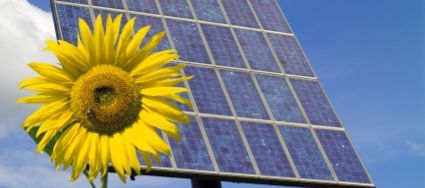|
Solar Energy Costs
There are many ways of looking at solar energy costs, and as we’ve talked about on other pages on this site there are lots of forms of solar energy. On this page, I’m going to talk specifically about the costs of producing electricity from photovoltaic solar panels. This is quite distinct from the costs of things like commercial solar power plants, solar hot water, solar home heating and so forth. How to Measure a Solar PanelTo begin our discussion of solar energy costs, let’s define a solar panel unit of measure. We buy gas by the gallon and meat by the pound. What’s an appropriate measure of a solar panel? What we’re interested in, of course, is the amount of electricity that the panel produces, not how big it is or how much it weighs. A solar panel's output depends on the light striking it, so the industry has developed fairly standardized conditions of testing. This method classifies a panel according to the electricity produced under these conditions. The measurement is expressed as watts peak (Wp). Dividing the cost of a panel by its power output gives a cost per Wp that can be used for comparison purposes. The cost per Wp is only one factor in determining the total cost of a photovoltaic system. Factors Affecting Solar Panel PerformanceThe testing of the panels is done under standardized conditions. If you take the same panel and install it in the Arizona dessert it’s going to produce an entirely different amount of electricity in a year than if it is installed in the cloudy Northwest. Factors like climate, installation, amount of shade on the panels and so forth affect how much electricity a given panel produces once installed. Within a given climate and installation situation, how much electricity you want from your solar system will determine how many panels you’ll need. Again, someone with a small home who only wants to provide about 25% of their electricity needs from solar energy needs a different number of panels than someone with a larger home who wants to be off the grid completely. These are the factors that determine the number of panels needed for a given system. Other Factors Affecting Solar Energy CostsHowever, the expense of the panel represents only about 40% of a typical photovoltaic system. Other factors affect solar energy costs. These other expenses include mounts, wiring, meters, inverters, batteries (if used) and labor. The Bottom LineI know it’s a little frustrating to hear generalities if you really want to know “What does it cost?” To put more of a “bottom line” on this, a typical installation designed to supply a high percentage of the electricity needs of a house connected to the grid typically runs $12,000-$25,000. That’s a very rough guide, but gives you an idea. Solar installers in your area can give you a much more accurate estimate. Many states have tax rebates or credits that reduce the out of pocket cost to the homeowner considerably. The payback time, meaning how long it takes to recover the expense of the system from money saved on fuel bills runs between 10 and 20 years depending on what you pay for power off the grid. If you get a tax rebate or if energy costs go up, the payback time will be shorter. I talked to a solar installer in my area and he says that most of the people he’s doing work for are having the system put in mainly out of concern for the environment. The energy costs savings over time are a bonus. One situation where solar systems are very cost effective right now are situations where a people are building a new home any distance from the main utility line. With the costs of running a line in being between $10 and $20 a foot, in most situations installing a photovoltaic system is cheaper if the line has to go much over ½ mile. LinksConcentrating Solar Energy Systems Click here to go to Alternative Energy Primer Home from Solar Energy Costs |
